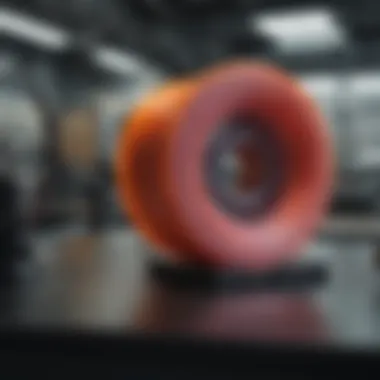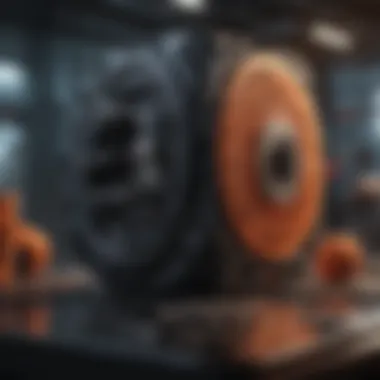Leading 3D Printing Companies Shaping the Future


Intro
The 3D printing industry has experienced remarkable evolutions over the past decade. This analysis focuses on the leading companies that have consistently pushed the boundaries of what is possible in additive manufacturing. By understanding their strategies, innovations, and market positions, one can gain insights into the broader landscape of technology and manufacturing.
In the following sections, we will provide a thorough overview of the current market conditions affecting 3D printing. We will also delve into stock analysis, identify potential investment strategies, and evaluate key players in the market. The relevance of this exploration cannot be overstated, as the implications of 3D printing extend beyond manufacturing into sectors such as healthcare, automotive, and aerospace. The intent here is to equip investors and professionals with a detailed understanding of the market dynamics and opportunities that these companies present.
Market Overview
Current Market Conditions
The 3D printing market is characterized by rapid technological advancements and increasing adoption across various industries. As of now, the market is estimated to be valued at approximately $15 billion, with expectations to grow over the next few years. This growth is driven largely by the continuous innovation in materials and printing technologies, alongside a rising demand for customized and on-demand products.
Key Economic Indicators
Several economic indicators provide insights into the 3D printing sector's performance:
- Market Growth Rate: The compound annual growth rate (CAGR) stands at around 20%, reflecting strong interest and investment.
- Investment Trends: Venture capital and private equity funding in 3D printing companies have surged, indicating optimistic future prospects.
- Consumer Behavior: Industries are increasingly leaning towards sustainable, cost-effective production methods.
Major Market Trending Factors
The following factors are instrumental in shaping the landscape of the 3D printing market:
- Technological Advancements: Innovations in hardware and software are enhancing production capabilities.
- Material Development: New materials, including metals and bio-materials, broaden application possibilities.
- Regulatory Changes: Evolving regulations are supporting the introduction of 3D-printed products in sectors like healthcare.
Through this analysis, readers will better understand the core drivers behind the competitive strategies of the major players in the industry, laying the groundwork for a deeper examination of each company's contributions and market positioning.
Understanding 3D Printing Technology
3D printing is a revolutionary technology reshaping manufacturing, prototyping, and various applications. It offers numerous benefits, such as reduced material waste, design flexibility, and the ability to create complex structures that were difficult or impossible to achieve through traditional manufacturing methods.
The importance of understanding this technology lies in its strategic relevance in the current market. Knowledge of 3D printing's capabilities and limitations can inform not only investment decisions but also operational strategies within industries. This section examines both the history and evolution of 3D printing, and its core technologies. Each element contributes significantly to the overall competence of 3D printing companies in various sectors.
History and Evolution of 3D Printing
The concept of 3D printing began in the early 1980s with the invention of Stereolithography by Charles Hull. This initial development marked a pivotal point in manufacturing technology. Over the decades, 3D printing evolved rapidly, with innovations leading to various technologies being introduced, such as Fused Deposition Modeling and Selective Laser Sintering.
These advancements have expanded the applications and capabilities of 3D printing, making it suitable for various sectors, from prototyping to healthcare. Today, 3D printing continues to progress, pushing boundaries further with ongoing research and development.
Core Technologies Used in 3D Printing
Understanding core technologies underpins further insights into the capabilities of 3D printing. Each technology has distinct characteristics, contributing to the diverse applications of 3D printing.
Fused Deposition Modeling (FDM)
Fused Deposition Modeling is widely recognized for its robust and straightforward approach. The key characteristic of FDM is its layer-by-layer construction of objects by extruding thermoplastic filaments. This makes FDM a popular choice for various applications due to its ease of use and cost-effectiveness.
A unique feature of FDM is its capability to print functional prototypes rapidly. However, some disadvantages include limited material options and lower resolution compared to other technologies.
Stereolithography (SLA)
Stereolithography remains one of the most established 3D printing methods. The key characteristic of SLA is its use of ultraviolet light to cure liquid resin into solid objects. This technology delivers excellent precision and fine details, making it a beneficial option for intricate designs.
A unique feature of SLA is its ability to create complex geometries. Nevertheless, the main disadvantage is the need for post-processing, which can be time-consuming and may require additional steps.
Selective Laser Sintering (SLS)
Selective Laser Sintering employs a laser to fuse powdered material into solid structures. The key characteristic of SLS is its versatility in handling a variety of materials, including plastics and metals, making it a valuable technology in many industries.


A unique feature of SLS includes the capacity to create durable and functional parts without the need for support structures. However, one of the disadvantages is the higher cost associated with both materials and equipment.
Applications of 3D Printing Across Industries
3D printing has penetrated various sectors. Its applications demonstrate the technology's versatility and transformative impact across industries.
Healthcare and Medical Equipment
The use of 3D printing in healthcare has become increasingly prominent. The technology allows for the production of custom medical devices, prosthetics, and even bioprinting of tissues. The key characteristic here is personalization, which enhances patient outcomes and recovery.
A unique feature of 3D printing in healthcare is the ability to produce on-demand, reducing inventory costs. However, the primary disadvantage involves regulatory hurdles, which can slow down product development.
Aerospace and Automotive
In the aerospace and automotive sectors, 3D printing addresses the need for lightweight components and efficient manufacturing processes. The key characteristic of this application is the enhancement of performance through weight reduction.
A unique feature of using 3D printing in these industries includes rapid prototyping, which significantly shortens the product development cycle. The disadvantage primarily relates to the regulations and certifications required for final products.
Consumer Products and Fashion
In consumer products and fashion, 3D printing has fostered creativity and customization. The key characteristic is its capacity to produce unique designs that cater to individual preferences.
A unique feature is the ability to lower production costs while reducing lead times. However, there can be disadvantages such as scalability challenges when attempting to mass-produce designs typical to these markets.
Industry Analysis of 3D Printing Companies
The analysis of 3D printing companies in the modern marketplace is crucial for understanding the dynamics that shape the sector. This part of the article examines key players, their strategies, and the overall market context. By evaluating how these companies operate, we can uncover trends and identify challenges that may impact future developments in the field. Investors and professionals must grasp these details to make informed decisions regarding investments and collaborations in 3D printing technology.
Market Overview and Key Players
The 3D printing industry is a rapidly evolving landscape. It comprises various companies with distinct offerings and capabilities. The field can be categorized into major players like Stratasys, 3D Systems, and Formlabs, each specializing in specific printing technologies.
- Stratasys: Known for its strength in Fused Deposition Modeling (FDM) and PolyJet technologies, Stratasys consistently innovates and broadens its market reach.
- 3D Systems: As a pioneer in 3D printing solutions, this company has a foundation built on pioneering patents and diversified applications.
- Formlabs: Dominating the SLA space, Formlabs has revolutionized desktop 3D printing with accessible and high-quality solutions.
Other notable companies like HP, Inc. and EOS also play significant roles, each disrupting the market with unique technologies. It's essential to recognize that understanding these key players helps to identify trends and practices shaping the industry's future.
Financial Performance and Investment Trends
Financial performance is a vital indicator of a company's health within the 3D printing industry. Investors look closely at revenue growth, profit margins, and return on investment. Recent data shows that many companies are on an upward trajectory, prompted by increasing demand across various sectors such as healthcare and automotive.
- Investment trends highlight a growing interest in sustainable practices. Companies adopting environmentally friendly materials or recycling processes attract investors focused on sustainability.
- Furthermore, mergers and acquisitions have been prevalent. This activity consolidates resources and expertise, positioning companies for growth.
Understanding financial metrics is critical. Investors must evaluate
key performance indicators that reflect operational efficiency and market position.
Overall, recognizing these trends can assist investors in forecasting future movements within the market.
Leading 3D Printing Companies in the Market
The landscape of 3D printing is continually evolving, and the companies that lead this space have a profound impact on its direction. Firms like Stratasys, 3D Systems, and others shape the technology's advancements and applications in diverse sectors. Understanding these companies gives valuable insight into innovation and market trends for potential investors.
Leading companies contribute to the development and adoption of 3D printing technologies in multiple ways. They enhance efficiency in manufacturing processes, reduce costs, and enable rapid prototyping. These factors not only influence their market positioning but also attract investment and facilitate industry growth. In this section, we will evaluate key players in the industry, focusing on their contributions and the competitive advantages they offer.
Stratasys: Innovator in FDM and PolyJet Technologies
Stratasys has established itself as a pioneering force in the 3D printing market, particularly known for its Fused Deposition Modeling (FDM) and PolyJet technologies. These methods allow for a wide range of applications, from prototyping to production. FDM technology is favored for its accessibility and cost-effectiveness, making it a popular choice among startups and established companies alike.
With PolyJet technology, Stratasys offers intricate designs with multi-material capabilities. This technology can produce parts that combine various materials, enhancing functional performance. Their focus on innovation has kept Stratasys at the forefront of the industry, consistently delivering high-quality printers that meet the demands of various sectors, including aerospace and medicine.
3D Systems: Pioneer in 3D Printing Solutions


3D Systems was an early entrant into the 3D printing market, recognized for its comprehensive suite of solutions. From hardware to software, the company offers a wide diversity of products that cater to both industrial and personal use. 3D Systems has been a leader in creating advanced printing technologies. It innovated Stereolithography (SLA), the first 3D printing process, bringing it to the mainstream.
Their commitment to research and development ensures continuous improvements in performance and capabilities. The company excels in providing tailored solutions for sectors like healthcare, where custom implants and dental devices have become more common.
Formlabs: Market Leader in SLA Technology
Formlabs has emerged as a significant player focusing primarily on Stereolithography technology. Its printers are designed to facilitate high resolution and fast printing speeds. This capability is attractive to a variety of industries, particularly in the dental and jewelry sectors, where precision is paramount.
The company has simplified access to SLA technology by providing affordable printer options without compromising quality. Formlabs' approach includes an ecosystem of software and materials, which supports users in various applications. This strategy has propelled Formlabs to the forefront of the desktop 3D printing segment.
HP Inc.
: Disruptor with Multi Jet Fusion Technology
HP Inc. is reinventing the 3D printing landscape with its Multi Jet Fusion technology. This approach allows for the production of functional parts quickly and at a competitive cost. By leveraging its expertise in traditional printing, HP distinguishes itself in the 3D space.
Multi Jet Fusion's unique method enables detailed and strong parts, making it suitable for various applications, from prototyping to end-use products. Additionally, HP is committed to sustainability by emphasizing recyclable materials, which resonates with a growing market sensitivity towards environmental issues.
EOS: Specialized in Industrial 3D Printing
EOS stands out as a key player focused on high-end industrial 3D printing solutions. With an emphasis on Selective Laser Sintering (SLS), EOS offers systems capable of producing high-quality parts with superior material properties. The technology is well-suited for applications requiring robust performance under stress, such as in aerospace and automotive sectors.
The company's strategic partnerships and customer collaboration enhance its product offerings, allowing for customizable solutions. EOS also emphasizes a system-oriented approach, providing comprehensive services that support customers throughout their 3D printing journey.
"The integration of advanced technologies and customer-centric solutions distinguishes the leading 3D printing companies in the market."
In summary, the leading 3D printing companies are redefining manufacturing processes across various industries. Their innovations not only drive business growth but also set the stage for future developments in technology. Understanding these key players offers potential investors critical insights into the market dynamics shaping the future of 3D printing.
Challenges Faced by 3D Printing Companies
The 3D printing industry is not only vibrant but also faced with unique challenges. Recognizing these challenges is crucial for understanding the dynamics that govern the market landscape. Constraints like regulatory pressures, intellectual property disputes, and supply chain complexities can significantly impact company operations and strategy. A thorough analysis of these aspects will enable individual investors and financial professionals to make informed decisions in this evolving space.
Regulatory and Compliance Hurdles
Regulatory frameworks surrounding 3D printing vary widely by region and application. Companies must navigate complex regulations that often lag behind technological advancements. This is particularly true in sectors like healthcare, where medical devices created through 3D printing must meet stringent safety standards. Compliance with these regulations can increase operational costs and extend product development timelines, posing risks for companies aiming for rapid market entry.
Moreover, the fast-paced nature of innovation complicates the regulatory landscape. Agencies like the FDA in the United States have begun developing guidelines, but challenges remain in areas such as material safety and manufacturing processes. Understanding these regulations is vital for businesses in the 3D printing sector, as it directly influences their market strategies and growth potential.
Intellectual Property and Patent Issues
Intellectual property (IP) protection is a pressing issue in the 3D printing industry. The ease of copying complex designs can lead to patent infringement, making it harder for companies to protect their innovations. Many organizations report concerns that competitors could easily replicate their proprietary technologies, undermining their competitive advantage.
Legal battles over patents have become commonplace, consuming valuable resources and focus. For instance, companies like 3D Systems and Stratasys have historically engaged in litigation over their respective patents. This situation fosters a climate of uncertainty, deterring innovation at times when companies need to be agile and adaptive to market demands.
Properly addressing these IP concerns is crucial for fostering an environment of creativity and progress. Companies that successfully manage their patent portfolios may gain significant market leverage.
Supply Chain and Material Limitations
The supply chain in 3D printing presents distinct challenges. Dependence on specific materials can constrict production capabilities. Fluctuations in the availability of high-performance materials may cause delays and elevate costs. This is particularly evident in industries where custom materials are required for specialized applications.
Additionally, logistical concerns are amplified when companies adopt just-in-time manufacturing techniques, which are common in 3D printing. Any disruption in material supply can halt production lines. To mitigate these risks, companies must develop robust relationships with suppliers and invest in planning and predictive analytics.
In summary, the challenges faced by 3D printing companies are multifaceted. Regulatory hurdles, intellectual property risks, and material supply chain issues create a complex landscape that could influence market dynamics. Awareness and understanding of these challenges will enable investors and professionals to make more astute decisions in the 3D printing sector.
Future Trends in 3D Printing
The landscape of 3D printing is constantly evolving. Understanding future trends is crucial for investors and industry professionals. These trends can shape market dynamics, influence company strategies, and lead to significant advancements in technology and applications. The following subsections delve into major trends that are expected to shape the future of 3D printing.


Advancements in Materials and Processes
Materials innovation is a primary factor in the advancement of 3D printing. Researchers are focusing on new substances that can improve the performance, durability, and functionality of printed objects. For instance, there is significant interest in bio-based materials, which can have applications in medical fields and beyond.
Moreover, existing materials are being modified. For instance, composite materials that incorporate carbon fiber or metal powders offer enhanced strength without adding much weight. This is particularly relevant in sectors like aerospace and automotive, where reducing weight without compromising structural integrity is vital.
Processes are also advancing. Techniques like Continuous Liquid Interface Production (CLIP) are pushing the boundaries of speed and quality in 3D printing. This method allows for faster production while maintaining high detail and resolution. As these advancements continue, they provide industries with unique solutions to challenges that were previously difficult to overcome.
Integration with AI and IoT Technologies
The integration of Artificial Intelligence (AI) and the Internet of Things (IoT) into 3D printing opens new pathways for innovation. AI can facilitate design optimization, where algorithms analyze designs for manufacturability or suggest improvements. Enhanced design processes minimize material waste and time spent on revisions.
IoT technologies enable the connection of 3D printers to the cloud, allowing for real-time monitoring and data collection. This connectivity can improve maintenance practices by predicting equipment failures or required repairs. Companies can leverage this data to optimize production efficiency and reduce downtime, ultimately impacting their bottom line positively.
The collaboration of AI and IoT with 3D printing can lead to smarter manufacturing processes. For example, on-demand production facilitated through IoT means that companies can respond quickly to market demands without holding large inventories.
Sustainability and Recycling in 3D Printing
Sustainability is a growing concern across all industries, and 3D printing is no exception. The ability to create products on demand helps to reduce waste associated with traditional manufacturing methods. Companies are exploring ways to recycle failed prints or leftover materials, ensuring a more circular economy within the sector.
Materials that are recyclable or made from recycled substances enhance the sustainability of 3D printing. Some companies are innovating with biodegradable filaments. This grants manufacturers not just ecological benefits but also aligns with consumer preferences for sustainable products.
In essence, sustainability efforts in 3D printing not only address environmental responsibilities but can also lead to cost savings in material procurement and waste management. Investors looking for companies with a forward-thinking approach will find opportunities in those prioritizing sustainable practices.
The future of 3D printing involves more than just technological improvements; it requires a commitment to sustainability, intelligent integration, and materials innovation to shape a more efficient and responsible industry.
Investment Considerations in 3D Printing Stocks
Investment in the 3D printing industry represents a unique opportunity for financial growth. As this field rapidly evolves, recognizing the intricacies surrounding company performance and market trends becomes crucial for investors. Understanding how to evaluate potential investments can lead to better decision-making, mitigating risks and enhancing potential returns.
Evaluating Company Performance Metrics
Investors should focus on specific metrics to assess the health and performance of 3D printing companies. These performance indicators provide insight into profitability, growth potential, and operational efficiency. Key metrics include:
- Revenue Growth: Consistent revenue increases signal a company’s ability to expand its market share. Investors should look for historical trends in quarterly and annual reports.
- Profit Margins: Analyzing gross and net profit margins helps investors understand operational efficiency. High margins may indicate strong pricing power and effective cost management.
- Research and Development (R&D) Spending: In a technology-driven field like 3D printing, a company’s commitment to R&D is vital. Significant investment in innovation often correlates with competitive advantages.
- Return on Investment (ROI): Evaluating the ROI of different projects can help gauge the effectiveness of a company's strategy. A higher ROI suggests better allocation of resources.
By closely examining these metrics, investors can procure a clearer understanding of a company's financial health and future prospects.
Market Sentiment and Analyst Ratings
Market sentiment often influences stock performance significantly. Analysts provide ratings and forecasts based on their assessments of market trends and company developments. Investors should pay attention to:
- Analyst Buy/Sell Ratings: Analyst recommendations can offer insight into expected stock performance. A high percentage of 'buy' ratings may indicate optimism within the market.
- Price Target Adjustments: Changes in price targets can reflect shifting market sentiments. Investors should consider these adjustments seriously when evaluating potential investments.
- Earnings Reports and Guidance: Quarterly earnings releases provide essential information about a company’s financial performance. Analysts often adjust ratings and forecasts based on earnings surprises or guidance updates.
Understanding the market sentiment and how analysts perceive the companies in the 3D printing space offers valuable perspectives. This knowledge helps investors make informed choices amidst fluctuating market conditions.
End and Implications for Investors
The analysis of prominent 3D printing companies sheds light on a dynamic and rapidly evolving industry. As 3D printing technologies continue to advance, they are poised to disrupt traditional manufacturing processes and create new opportunities for growth. Understanding these developments is crucial for investors seeking to navigate this complex market.
Importance of the 3D Printing Sector
Investors must recognize that 3D printing is not only a technological trend; it has the potential to redefine various sectors. The applications span from healthcare, with custom medical devices and prosthetics, to aerospace, where lightweight components can enhance fuel efficiency. Thus, the implications for market investment strategies are significant. Evaluating companies based on their technological innovations and market positioning can provide valuable insights into their potential for sustained growth.
Key Considerations for Investment
- Market Positioning: Companies like Stratasys and 3D Systems hold significant market shares and draw attention from investors. Their established track records can indicate stability, yet up-and-coming firms that offer innovative solutions might provide higher returns.
- Technological advancements: Continuous improvements in 3D printing methods and materials are vital. Firms that invest heavily in R&D are likely to stand out and could attract investor interest.
- Economic landscape: Understanding broader economic trends that impact manufacturing and supply chains will help investors position themselves effectively in this sector. Economic downturns can affect investment in new technologies but may also offer opportunities for companies that improve efficiencies through 3D printing.
- Regulatory environment: As highlighted earlier, regulatory hurdles can pose challenges. Investors should stay informed on how these regulations may affect operations or the introduction of new technologies.
- Consumer demand: The appetite for customized and quick-to-manufacture products is rising. Companies that tap into this trend may experience growth, making them attractive for investment.
"Investors looking at 3D printing should consider both established firms and innovative newcomers to balance potential risk and reward."
Implications for Future Investing
Given the rapid pace of change in the 3D printing industry, investors are advised to stay updated on technological trends and emerging companies. Market sentiment will also play a role, as investor confidence can sway based on perceived innovation or market demand. With a mix of established players and novel innovators, a diverse investment approach may yield the best outcomes. Understanding these dynamics can help investors make informed decisions that align with their risk tolerance and investment goals.







